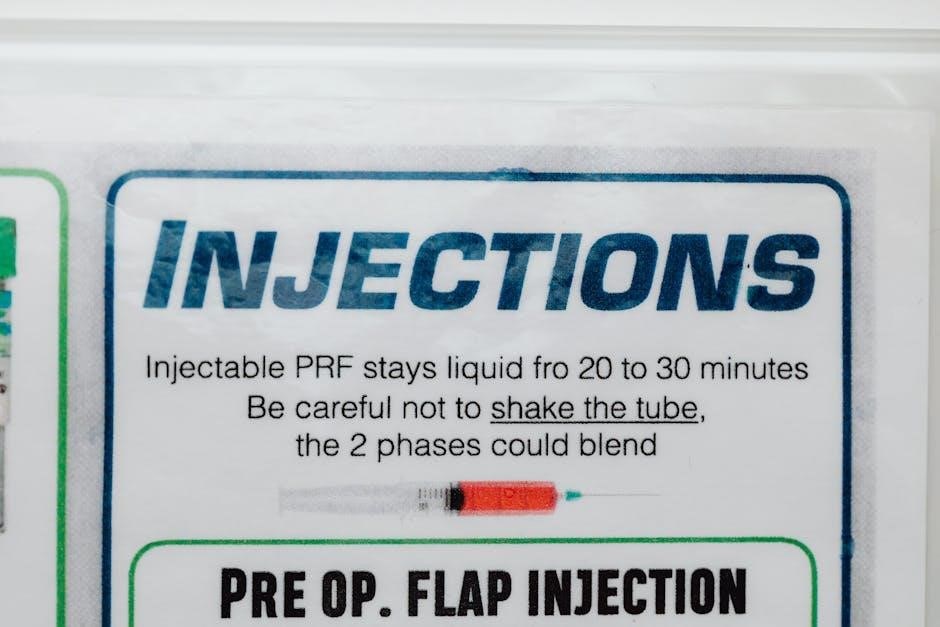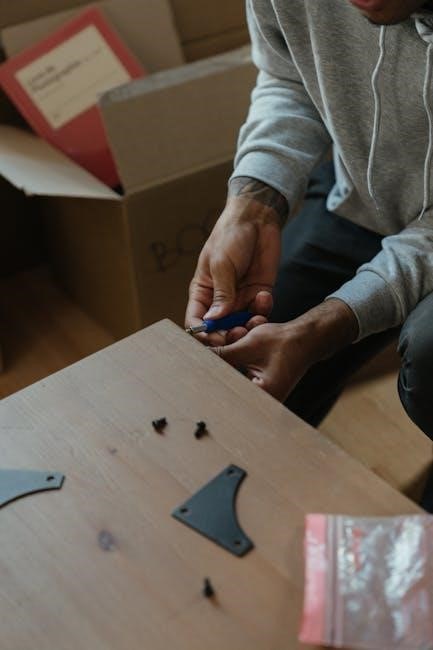
TheraCal LC Instructions: A Comprehensive Guide
TheraCal LC, a resin-modified calcium silicate, provides pulpal protection and acts as a liner during restorative procedures. This guide details its application protocol,
covering preparation, application, and post-operative care, ensuring optimal clinical outcomes.
TheraCal LC represents a significant advancement in dental materials, specifically designed for pulp protection and as a biocompatible liner. Introduced by Bisco Dental Products, this resin-modified calcium silicate emerged as a novel approach to internal flowable pulpal protectants. Its development addressed the need for materials offering both the benefits of calcium release and the ease of handling associated with resin-based systems.
Initially launched at the Greater New York Dental Meeting, TheraCal LC quickly gained recognition for its potential in direct and indirect pulp capping, as well as its utility during restorative procedures. The material’s unique composition aims to stimulate dentin bridge formation and minimize post-operative sensitivity, offering clinicians a reliable solution for vital pulp therapy. Understanding its properties and proper application is crucial for successful clinical outcomes.
What is TheraCal LC?
TheraCal LC is a light-cured, resin-modified calcium silicate material specifically formulated as a pulp protectant and liner. It’s designed for direct or indirect pulp capping applications, offering a biocompatible barrier to safeguard the dental pulp. Unlike traditional materials like formocresol, TheraCal LC doesn’t require mixing, simplifying the clinical procedure.
This material distinguishes itself through its ability to release calcium ions, promoting a favorable biological response and potentially stimulating dentin bridge formation. It’s indicated for use on moist dentin, providing a seal against microleakage and reducing post-operative sensitivity. TheraCal LC is presented in a convenient syringe delivery system, allowing for precise placement and controlled application within the prepared cavity.
Composition and Properties
TheraCal LC’s composition centers around calcium silicate, blended with a resin matrix. This unique combination delivers both the bioactive benefits of calcium release and the handling characteristics of a resin-based material. The calcium silicate component encourages dentin bridge formation, aiding in pulp protection and repair.
Key properties include its radiopacity, allowing for clear visualization on radiographs, and its low solubility, minimizing marginal breakdown. It exhibits excellent adhesion to both dentin and composite resins, ensuring a robust seal. Being light-cured, TheraCal LC offers a convenient and efficient setting mechanism. Its flowability allows adaptation to irregular cavity shapes, while its minimal shrinkage reduces the risk of microleakage and post-operative sensitivity.

Preparation and Application Protocol

Successful TheraCal LC application requires meticulous tooth isolation, careful cavity preparation, and appropriate dentin conditioning before material placement and light curing.
Step 1: Tooth Isolation
Tooth isolation is paramount before initiating any restorative procedure involving TheraCal LC. Effective isolation prevents salivary contamination, ensuring optimal bonding and material performance. Utilize a rubber dam whenever clinically feasible to create a dry, clean operative field.
Carefully apply the rubber dam clamp, ensuring secure placement without traumatizing the gingival tissues. If a rubber dam is not possible, employ cotton rolls and a high-volume evacuator to maintain a dry environment. Moisture control is critical, as water can interfere with the material’s setting and adhesion properties.
Confirm complete isolation before proceeding to the next step. A compromised seal can lead to microleakage and potential pulpal irritation, negating the benefits of TheraCal LC’s protective qualities.
Step 2: Cavity Preparation
Following successful tooth isolation, meticulous cavity preparation is essential for TheraCal LC application. Remove all caries-affected dentin using standard operative techniques, creating a clean and defined cavity shape. Ensure cavity walls are smooth and provide adequate resistance and retention form for subsequent restoration.
Avoid excessive cavity preparation, preserving as much healthy tooth structure as possible. The prepared cavity should be free of debris and contaminants. A final rinse with water, followed by thorough drying with air, prepares the surface for dentin conditioning.
Carefully assess the proximity of the preparation to the pulp. This assessment guides the decision between direct or indirect pulp capping, influencing the amount of TheraCal LC applied.
Step 3: Dentin Conditioning
Dentin conditioning is a crucial step prior to TheraCal LC application, enhancing its bonding and sealing capabilities. Apply a self-etching dentin conditioner to the prepared dentin surface, following the manufacturer’s instructions. This etches and primes the dentin simultaneously, creating a hybrid layer for optimal adhesion.
Ensure complete coverage of all dentin surfaces intended for TheraCal LC application, avoiding pooling within the cavity. Gently air-dry the conditioned dentin, leaving it visibly moist – a critical factor for successful bonding.
Avoid over-drying the dentin, as this can compromise the hybrid layer formation. The conditioned, moist dentin provides an ideal substrate for TheraCal LC, promoting its integration and bioactivity.
Step 4: Application of TheraCal LC ─ Layer Thickness
Apply TheraCal LC directly onto the conditioned, moist dentin in increments. A thin layer, ideally less than 1mm in thickness, is recommended to prevent material flaking and ensure adequate light curing penetration. Utilize the provided applicator tip for precise placement, reaching all areas requiring pulp protection.
Avoid excessive material application, as thicker layers may lead to polymerization inhibition and compromised mechanical properties. Build up the layer gradually if necessary, ensuring each increment is properly light-cured before proceeding.
Maintaining a thin layer optimizes calcium release and promotes dentin bridge formation, contributing to pulp vitality and long-term success.
Step 5: Light Curing Parameters
Effective light curing is crucial for optimal TheraCal LC polymerization and performance. Utilize a dental curing light emitting wavelengths within the visible light spectrum, typically between 400-500nm. A minimum light intensity of 600 mW/cm² is recommended for consistent results.
Expose each increment of TheraCal LC to light for 20 seconds. Ensure proper positioning of the curing light tip, maintaining close proximity to the material surface without direct contact. Overlap curing areas slightly to eliminate any potential polymerization shadows.
Verify complete curing by visually inspecting the material for any remaining tackiness. Insufficient curing can lead to material degradation and increased risk of post-operative sensitivity.

Clinical Applications of TheraCal LC
TheraCal LC excels in direct and indirect pulp capping, offering robust pulp protection during restorative work, and serving as an effective liner under composites.
Direct Pulp Capping
TheraCal LC is specifically designed for direct pulp capping, offering a biocompatible barrier to stimulate dentin bridge formation when a small, pinpoint mechanical exposure occurs. Following tooth isolation and caries removal, carefully apply a thin layer – less than 1mm – of TheraCal LC directly onto the exposed pulp.
Ensure the dentin remains visibly moist, as TheraCal LC performs optimally on hydrated surfaces. Light-cure for 20 seconds using appropriate parameters. This creates a protective seal, minimizing inflammation and promoting pulp healing. The calcium release from TheraCal LC contributes to the biological response, fostering reparative dentinogenesis.
Post-operatively, monitor the tooth for vitality and sensitivity, and consider a restorative build-up to provide long-term protection. This technique offers a conservative alternative to root canal therapy in select cases.
Indirect Pulp Capping
TheraCal LC excels in indirect pulp capping scenarios, where caries are extensive but no pulpal exposure is visible. After removing the majority of the infected dentin, leaving a thin layer over the pulp, apply TheraCal LC to create a protective barrier. This stimulates dentin formation, effectively sealing the remaining caries and safeguarding the pulp.
Apply a layer of less than 1mm thickness onto the moist dentin, ensuring complete coverage of the remaining caries. Light-cure for 20 seconds. The material’s calcium release promotes pulpal health and encourages reparative processes.
Following indirect pulp capping with TheraCal LC, a definitive restoration is crucial for long-term success. Monitor the tooth for vitality and sensitivity post-operatively, and assess radiographic evidence of dentin bridge formation.
Pulp Protection During Restorative Procedures
TheraCal LC serves as an exceptional pulp protector during restorative treatments, particularly when deep caries removal is necessary. Its biocompatibility and ability to stimulate dentin bridge formation minimize pulpal irritation and promote healing. Before placing a final restoration, apply a thin layer of TheraCal LC directly onto the exposed dentin.
Ensure the dentin remains visibly moist during application, as this enhances the material’s bonding and sealing capabilities. Light-cure for 20 seconds to polymerize the material, creating a robust protective barrier. This insulation reduces post-operative sensitivity and safeguards the pulp from thermal and mechanical stresses.
TheraCal LC’s calcium release further supports pulpal health, fostering a favorable environment for continued vitality;
Liner Under Composite Restorations
TheraCal LC functions effectively as a liner beneath composite restorations, offering crucial protection to the dental pulp. Its application is particularly beneficial in deep cavities approaching the pulp chamber, minimizing potential sensitivity. Apply a thin, approximately 1mm thick, layer of TheraCal LC onto the prepared cavity floor, ensuring complete coverage of any exposed dentin.
Maintain a moist dentin surface for optimal bonding and sealing. Following application, light-cure the material for 20 seconds to achieve full polymerization and create a durable base. This liner acts as a barrier, preventing microleakage and protecting the pulp from bacterial ingress and thermal shock.
TheraCal LC’s biocompatibility promotes long-term pulpal health under composite restorations.

Specific Application Techniques
Optimal results with TheraCal LC require precise techniques, including application on moist dentin, careful placement on the pulpal floor, and minimizing potential flaking.
Application on Moist Dentin
TheraCal LC demonstrates superior performance when applied to visibly moist dentin. Prior to application, gently blot the prepared cavity with a cotton pellet, ensuring the dentin surface remains adequately hydrated, but not overtly wet. This moisture facilitates optimal adaptation and bonding of the material to the tooth structure.
Applying a thin layer – less than 1mm in thickness – is crucial. This initial layer should be light-cured for approximately 20 seconds. This initial curing step is vital to prevent TheraCal LC from flaking or debonding during subsequent restorative procedures. Maintaining this moist environment throughout the application process is paramount for achieving a durable and effective seal, promoting pulp health and minimizing post-operative sensitivity.
Application to Pulpal Floor
When applying TheraCal LC directly to the pulpal floor of a prepared cavity, a precise and controlled technique is essential. Apply the material up to a thickness of 1mm, carefully covering the exposed dentin. This layer acts as an effective barrier, protecting the pulp from potential irritants during restorative treatment.
The application to the pulpal floor assists in reducing post-operative sensitivity by providing insulation. Following application, light-cure the material according to the manufacturer’s recommendations. Ensure complete polymerization to maximize its protective capabilities. This step is critical for establishing a stable base for subsequent restorative layers, promoting long-term pulp vitality and minimizing discomfort for the patient.
Technique for Minimizing Flaking
To prevent TheraCal LC from flaking off during and after application, a specific technique is crucial. Begin by applying a thin layer – less than 1mm in thickness – onto visibly moist dentin. Immediately following application, light-cure the material for a minimum of 20 seconds. This initial curing step is paramount in establishing a strong bond and preventing displacement.
Adequate light curing ensures proper polymerization and minimizes the risk of material breakdown. Avoid excessive manipulation of the material after placement, as this can disrupt the initial set. Maintaining a moist environment during application also aids in adhesion. Following these steps will significantly reduce the incidence of flaking, ensuring a durable and effective pulpal protection.

Post-Operative Considerations
TheraCal LC applications require monitoring for pulp vitality and managing potential post-operative sensitivity. Careful observation and patient communication are essential for success.
Post-Operative Sensitivity Management
TheraCal LC, while biocompatible, can occasionally induce post-operative sensitivity. This is often transient and related to the material’s proximity to the pulp. Applying TheraCal LC up to 1mm on the pulpal floor assists in reducing sensitivity through insulation.
Patients should be informed about the possibility of mild discomfort and advised to report any prolonged or severe pain. Over-the-counter analgesics, such as ibuprofen or acetaminophen, are typically sufficient for managing minor sensitivity. Avoiding extreme temperatures and occlusal contacts can also provide relief.
If sensitivity persists beyond a few days, re-evaluation is necessary to rule out other potential causes, such as marginal leakage or pulpal inflammation. Proper isolation and careful application technique during the initial procedure minimize the risk of prolonged sensitivity.
Monitoring for Pulp Vitality
Following a TheraCal LC application, particularly in direct or indirect pulp capping scenarios, regular monitoring of pulp vitality is crucial. Clinical assessments should include evaluating the tooth’s response to thermal stimuli – cold testing is commonly employed – to gauge pulpal health.
Radiographic examination, ideally at 3, 6, and 12-month intervals, helps assess for any periapical pathology or internal pulpal calcifications, which could indicate pulp necrosis. The absence of radiographic changes and a sustained positive response to thermal testing suggest continued pulp vitality.
Any changes in sensitivity, spontaneous pain, or radiographic signs warrant further investigation, potentially including pulp sensibility testing or cone-beam computed tomography (CBCT) to determine the need for root canal treatment.

Comparative Studies & Research
TheraCal LC demonstrates promising results in studies, notably versus formocresol in primary teeth, and exhibits beneficial biological effects due to calcium release during treatment.
TheraCal LC vs. Formocresol (Primary Teeth)
Research has directly compared the efficacy of TheraCal LC to formocresol when utilized in pulp capping procedures within primary teeth. A study involving thirty teeth in each group – one treated with formocresol and the other with TheraCal LC – evaluated clinical outcomes. The investigation aimed to assess the success rates and biological responses associated with each material.
Findings suggest TheraCal LC presents a viable alternative to formocresol, potentially offering advantages in biocompatibility and dentin bridge formation. While formocresol has historically been a standard for pulp therapy in primary teeth, concerns regarding its toxicity have prompted exploration of alternative materials like TheraCal LC. This comparative analysis contributes to the growing body of evidence supporting the use of resin-modified calcium silicates in pediatric dentistry, offering a potentially safer and equally effective option for pulp preservation.
Biological Effects of Calcium Release
TheraCal LC’s unique composition facilitates the release of calcium ions, triggering several beneficial biological effects within the dental pulp. This calcium release actively stimulates the formation of reparative dentin, promoting natural healing and pulp protection. The released ions also encourage the proliferation of odontoblasts, the cells responsible for dentinogenesis, bolstering the dentin bridge formation process.
Furthermore, calcium ions play a crucial role in modulating inflammatory responses, potentially reducing post-operative sensitivity and promoting pulp vitality. This bioactive property distinguishes TheraCal LC from inert materials, actively participating in the tooth’s natural defense mechanisms. The sustained release of calcium contributes to a favorable microenvironment, supporting long-term pulp health and enhancing the success rate of pulp capping and protection procedures.
Anesthesia Failure & TheraCal LC
Recent research, including a National Dental Practice-Based Research Network study, investigated potential associations between anesthesia failure during nonsurgical root canal therapy and the use of materials like TheraCal LC. While not directly causing anesthesia failure, the study highlighted factors that may coincide with its occurrence during procedures involving deep caries and pulp exposure.
It’s theorized that the material’s pH and bioactive properties could potentially influence local nerve sensitivity, possibly contributing to incomplete anesthesia in certain cases. Clinicians should be aware of this potential, ensuring adequate anesthesia and considering supplemental techniques when utilizing TheraCal LC, particularly in challenging cases. Thorough assessment of preoperative factors and meticulous anesthetic administration remain paramount for successful treatment outcomes.

Product Details & Handling
TheraCal LC is supplied in 4-syringe packages, requiring proper storage and adherence to precautions. Shelf life details are crucial for optimal material performance.
Package Contents
Each TheraCal LC package contains essential components for successful application. Specifically, you will find four individual syringes, each pre-filled with 2.5 grams of the resin-modified calcium silicate material. These syringes are designed for direct application to the prepared tooth surface, ensuring precise placement and minimal waste.
Additionally, each package includes a total of twenty disposable mixing tips. These tips are crucial for ensuring proper mixing of the material prior to light curing, contributing to optimal material properties and bonding. The package also contains five shade tabs, which aid in visual assessment of the material’s consistency and shade matching.
Finally, a comprehensive instruction for use leaflet is included, detailing the complete application protocol, precautions, and clinical considerations for achieving the best possible results with TheraCal LC.
Storage and Shelf Life

Proper storage is crucial to maintain the efficacy and properties of TheraCal LC. Unopened syringes should be stored in a cool, dry place, protected from direct sunlight and extreme temperatures, ideally between 2°C and 25°C (36°F and 77°F). Avoid freezing the material, as this can compromise its composition and performance.
Once a syringe has been opened, it is recommended to use it within a reasonable timeframe to prevent potential degradation of the material. While the exact timeframe may vary, it’s best practice to use the opened syringe within a few weeks. The shelf life for unopened TheraCal LC syringes is typically two years from the date of manufacture, as indicated on the packaging.
Always check the expiration date before use and discard any expired material to ensure optimal clinical outcomes and patient safety.
Precautions and Contraindications
TheraCal LC is generally well-tolerated, but certain precautions should be observed. Avoid using the material in patients with known allergies to any of its components, including calcium silicates or resin monomers. Direct pulp exposure exceeding 0.5-1.0mm may necessitate alternative treatment approaches.
Exercise caution when applying TheraCal LC near the pulp, ensuring a thin layer to avoid pulpal irritation. While designed for moist dentin, excessive moisture can affect bonding; blot the cavity dry before application. Do not use TheraCal LC as a substitute for proper endodontic treatment when indicated.
Contraindications include use in patients with active caries extending close to the pulp, and in situations where complete isolation cannot be achieved. Always follow standard dental safety protocols during handling and application.

Troubleshooting Common Issues
Addressing flaking involves a thin (<1mm) application and 20-second light curing. Difficulty curing often stems from insufficient light intensity or depth; ensure proper equipment.
Material Flaking
TheraCal LC flaking can be a frustrating clinical issue, but is often preventable with meticulous technique. The primary cause is typically applying the material in a layer that exceeds the recommended thickness of 1mm. A thicker layer may not fully polymerize, leading to compromised integrity and subsequent flaking during preparation or function.
To mitigate this, ensure a consistently thin application, carefully controlling the amount of material dispensed. Crucially, a 20-second light curing period is essential for adequate polymerization and bonding to the dentin substrate. Insufficient curing will dramatically increase the risk of material breakdown. Maintaining a moist dentin surface is also vital, but avoid excessive moisture that could dilute the material.
Finally, proper isolation is key to prevent contamination and ensure optimal bonding. Addressing these factors will significantly reduce the incidence of TheraCal LC flaking and contribute to long-term restorative success.
Difficulty with Light Curing
Encountering challenges with light curing TheraCal LC can stem from several factors. Ensuring the curing light’s output intensity is sufficient is paramount; regularly check the light’s calibration. The material’s radiopacity can sometimes create a false impression of incomplete curing, but proper exposure time is the key.
A 20-second curing cycle is generally recommended, but deeper cavities may necessitate longer exposure or incremental curing – applying the material in layers and curing each individually; Confirm the light probe is positioned correctly and close proximity to the material surface, avoiding angles that reduce light penetration.
Furthermore, the presence of pigments or contaminants within the cavity can inhibit polymerization. Thoroughly clean and dry the preparation before application. If issues persist, consider using a higher-intensity curing light or a different wavelength compatible with TheraCal LC’s photoinitiator.


